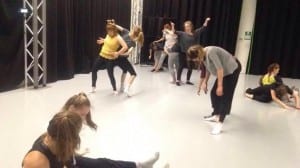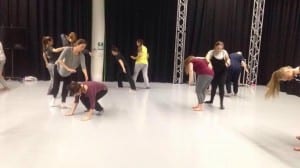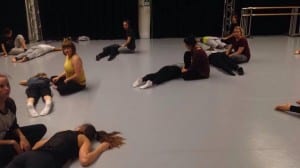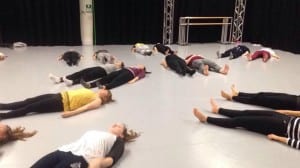Is stillness really stillness? Are our bodies moving without us even being aware of this?
From watching Steve Paxton’s Small dance video, the answers to these questions become obvious, the reflexes we have within our body, the twitches of the fingers, an itch on my body or the slight rocking of weight between the feet all cause us to move even when we believe our bodies are ‘still’.
Attempting to do this at the start of the session I found near impossible to ignore any reflexes or movement your body wanted to do, I did at points give into my reflexes. However, this exercise brought to life the smalldance video in my own body, and I felt where most of my reflexes come from and now my body is never still within the space.
As we proceeded more within our reflexes, feeling them and moving with them, I found movement that I never knew I could initiate from, for example I started to experiment with my little finger, which for me create non habitual movement.
We then started to look at three positions, table top, downward dog and child’s pose and how we could move within these positions, listening to our bodies and stretching and twisting with the body.
Bryon Brown discusses in ‘is contact a small dance?’ the idea of contact improvisation being ‘functional’ rather than ‘natural’, and I really thought about this idea of ‘functional’ during class and the improvisation jam this week.
‘it is functional to relax whilst falling because it takes less energy and it causes less energy upon impact’ (Brown, 1980-81, 73) ‘It is also functional to catch oneself with the arms because they can break the fall and not jar the system if the wrists, elbows and shoulders give with the weight’ (Brown, 1980-81,73)
This is something I kept thinking about during the improvisation jam and the class, and the more I practiced this the more the reading started to make sense. If we are not functional with our bodies how are we supposed to look after ourselves? How are we supposed to look after the other bodies within the space? How are we supposed to have safe practice?
We looked this week at trusting the other bodies within the space to catch us in a trust fall exercise.
‘bring attention to the fact that sensing the weight of the body from within also form part of situated and shared experience’ (Ravn, 2010, 21)
During this exercise I thought about sensing my weight and then releasing the weight into my peer’s body, I also thought about this when catching another body and sensing what part of the body needed to be held.
I found that I adapted to this exercise better than I thought I would, and was able to fully release myself and trust the other bodies to catch me.
Being lifted into the air was a difficult concept to grasp at first but as soon as I was up in the air all my anxiety went and I felt confident within myself and my peer’s.
Research Lab –
‘How does sensation and imagery help combat habitual movement?’
We explored the idea of sensation and imagery through touch, and explored how the same imagery and sensations can feel so different on different bodies and how this can affect our movement and thought patterns whilst moving with another body.
‘ ‘Simple’ physical contact involves feelings of pressure, of temperature, of roughness and smoothness, of resistance, and form’ (Smith,3)
We wanted to give the group as may different sensory and imagery ideas to work with as possible, giving them different pressures to work with and how that effect the way they moved, giving them an idea of resistance between to the two bodies (Magnetization) and giving them different body parts to work with this idea of resistance and pressure, for example, their feet had to magnetized together and they had to create movement around that, I realised that this was difficult to start with, however it pushed the group to create movement and experiment with movement that they hadn’t thought of before.
It was really interesting to watch how the different bodies found different ways of moving round the magnetization, one couple used the floor and the idea of an over and under dancer which was extremely interesting to watch.
Overall we had three exercises that we did with the group, the first entail exercise that we did was to get the group into this idea of imagery and bringing their attention into the space.
‘with the eyes closed and putting our body image out of mind, we build a very different picture of our presence’ (Brown, 1980-81, 75)
Many people within the group struggled with the first exercise and found it difficult to let the imagery take over their body, letting themselves be distracted by their own minds and body.
There was positive and negative feedback from the group at the end of the class, many found it difficult to have many things to think about in the last conversation touch task, and they said how they didn’t feel as though they combatted habitual movement, however from watching the group I feel like there was lots of movement created that wouldn’t necessarily have been created in a normal class.
Reflecting back on the class I feel that we had too many imagery and sensations for the group to think about whilst doing the last task which could be why the group struggled so much.
Bibliography –
Smith,R (2016). Kinaesthesia and Touching Reality. [online] Available at: http://www.19.bbk.ac.uk/articles/10.16995/ntn.691/ [Accessed 13 Oct. 2016]
‘Sensing weight in movement’. Full text available By: Ravn, SusanneJournal of Dance & Somatic Practices, 2010, Vol. 2 Issue 1
Paxton, S. (2009) Small Dance. Available from:https://www.youtube.com/watch?v=6sJKEXUtv44 (Accessed 23th October 2016)
Brown, B. Is Contact a Small Dance? contact improvisation sourcebook I. Vol. 6



